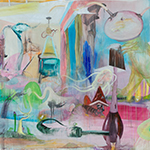Tabari Artspace presents Across a Velvet Horizon, a collaborative exhibitionby Egyptian artists Nada Baraka and Esraa Elfeky. The exhibition orbits a sense of incompleteness, an expanse of the unknown that speaks to thehuman impulse to make sense of the past – to impose coherence on chaos, and create stories that mend the gaps in what we know. Here, history isunfixed and left open to question. Viewers are invited to sit with uncertainty,to embrace the search even when the full picture remains tantalisingly out of reach.
Stepping into the exhibition space feels like entering an unfamiliar archive, a space where fragments of history hover, waiting to be pieced together. Visitors become both archaeologists and storytellers, reconstructing meaning from what remains. The works hint at an unspoken event – arupture – leaving the audience to work backwards, deciphering the traces left behind and the gaps they refuse to fill.
An atmosphere of mystery and discovery permeates the curation. Baraka’sevocative paintings and Elfeky’s tactile sculptures offer-up a dreamlikehaze, where memory feels fragile and incomplete. They offer a visualnarrative that blurs personal, cultural, and environmental histories,occupying a space between the real and the imagined. Rather than simply reflecting history the works on view confront its silences. Baraka’scanvases wrestle with memory as mutable, shifting under the weight ofinterpretation, while Elfeky’s sculptures suggest the land itself as a vesselof stories – holding onto lives long past, yet yielding only fragments.
Baraka’s paintings act as portals into fractured, surreal landscapes. Inspired by her late grandfather Ahmed Ali Kamal’s archive, her acrylic and oil canvases incorporate elements like postcards heavy with hidden emotions, their texts faintly discernible beneath vivid layers of paint. Works such as The Edge of Saudade (2025) and The Colour of Why (2025) exude an aching sense of longing, as though the past is slipping through one’s fingers. Baraka describes her process as engaging with the ‘antilogic’ of dreams, where memories are reimagined into surreal narratives. A wooden structure within the gallery serves as both sculpture and metaphor – a map inviting viewers to navigate these fragmented stories and construct connections of their own.
Elfeky’s sculptures, in dialogue, evoke artefacts from a lost world.Inspired by a desert plot in Cairo that was once submerged beneath thesea, her soft, fabric-covered forms resemble fossils or the remnants ofancient organisms. Her largest work, The Blue Wadi Resurrection,sprawls across the gallery floor like a relic unearthed from deep time, incontrast with works in smaller scale. Threads, leather, and fabricintertwine to create forms poised between decay and renewal,extinction and adaptation. Suspended sculptures hover in liminal spaces, as though caught between worlds, waiting to be deciphered.
Across a Velvet Horizon resists offering answers, instead provokingquestions and inviting the audience to engage with uncertainty. How dowe reconstruct history from fragments? What stories are hidden in thetraces left behind? And how do we come to terms with what is missing?
Press release from Tabari Artspace
Image: Nada Baraka. Flirting with time. 2025. Acrylic and oil on canvas. 235 x 195 cm. Image courtesy of the artist and Tabari Artspace



